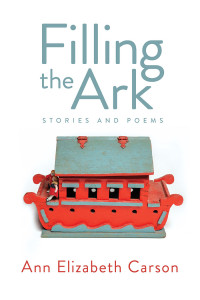 By: Ann Elizabeth Carson
By: Ann Elizabeth Carson
Photography: Callum Pinkney
Book layout: TwoCreative.ca
Nomad Art Press, 2019.
Available online through VolumesDirect.com >
In language brimming with a fierce love of the land and seascape, Filling the Ark is a cargo of essays, meditations, poetry and stories distilling the ups and downs of a long life and the hazards and gifts of growing old.
from Loose Ends p. 118–19:
Filling the Ark: Rich in sensuous details and meticulously observed, her travels to Manitoulin and Monhegan Islands glow with fierce love for the land and seascape. Her incisive, sometimes disturbing essays, meditations on human nature, environment, feminism and aging command our attention and response. Brimming with the wisdom of an elder determined to celebrate even as these moorings loosen and she leaves the ark behind to be filled with her children’s memories, this book is a treasure.
―Donna Langevin, author of Brimming and Timed Radiance
Responses & Reviews
Filling the Ark is a deeply thoughtful existential conversation that shifts effortlessly between poetry and prose. It reflects a life lived with conscious attention to the myriad details that both enhance and challenge existence. Best of all, it gives the lie to the notion that with age comes diminishment.
—Sean Arthur Joyce, author of Laying the Children’s Ghosts to Rest, The Price of Transcendence, Mountain Blues.
“I watch the day decide what to be. Will it be flopping laundry or blank pages filled?” Ann Elizabeth Carson is brilliant at capturing such moments in this deeply contemplative selection, attuned to the way things feel: frozen cracks in the boardwalk crackle/under blanket-muffled babies in big-wheeled strollers. Garden plants remind her of where we all come from and profess: nobody with deep roots can grow in shallow beds. Carson distills a wealth of experience, as form and substance find consummate agreement in precisely crystallized moments and generous narratives. She lays claim to the gifts aging leaves on the shore. Her poems redeem, salvage and console, as in the first swim/of the day, (when she) can’t walk down the slope to the dock … stars/will still beckon tonight through racing clouds. The swimmer, a leitmotif that aptly points to the art of growing old gracefully, is one of many engaging elements in Carson’s work—poetry and prose infused with pragmatic optimism: we have memory so there will be roses in December.
– Tom Gannon Hamilton, PhD, author, Panoptic, Aeolus House Press, 2018. Founder, Urban Folk Art Salon.
Ann Elizabeth Carson fills her tenderly carved ark with what Uncle Jack would never see—stories of his family as it unfolded over several generations after his premature death, insights into life from his now 90-year-old niece, vivid sketches of nature and the psyche in verse and stories. Ann covers the terrain from evocative portraits of lakeside life to human-induced extinction of up to 200 species a day and Darwin’s writing about the sentience of plants. The ark voyages skilfully from 1929 to 2019, inviting the next generations to fill it with their own stories.
– Anne Champagne, MES, Owner of Green Words Writing and Editing, author of The Talking Spade.
Excerpts
I’ve Been Thinking, p. 8
My great granddaughter said to her mother recently, “Nana is old.”
“Yes,” my grandchild replied, “she is old.”
“Is she going to die?”
“Yes, she will die. But she is healthy now and is not going to die right away.”
“Well,” said this dear child, “when she dies, I want to see her spirit!”
“Spirit is not something outside of us that you can see, like another person,” her mother explained. “Spirit is inside us.”
“Oh,” said her daughter. “Is it in her bones?”
Where will our spirit rest? Like an insect trapped in amber, what artifacts do we wish to leave behind? Something more than mammoth landfills, stinking scummy shorelines and islands of plastic-changing ocean currents….
What is our wisdom letter in a bottle cast on the ocean of the unknown?
What revealing bones will we leave?
Postcard Poem: First Warmth, p. 73
Clear sky to the east speaks of a sunny day
criss-crossing waves tell another story. Soon
low cumulus clouds present dark underbellies. The wind
turns chill. My dressing gown discarded, I hurry back
inside to get it, determined to breakfast outside
and watch the day decide what to be.
Will it be flopping laundry or blank pages filled?
Given a choice, what is my desire?
Simple Sentences, p. 42
spring buds on wet branches
messengers of time
leaf backs
on a bright summer day
storm warning
waking autumn days
shadow dreams
in double vision
dark November cloud
silent
as unspoken history
snow bound,
listening
for the kindness of shovels
East Wind, p. 53
She blows in late afternoon, we hug, eat supper. She unpacks, feeds the dog, then strolls around the cottage taking the measure of the place: air circulation possibilities, stones to the dock need leveling … or is there another, less precarious, way to get there? I imagine solutions wheeling around inside her close-cropped, now greying head.
While I read in the comfort of her come-and-go presence she is outside again, exploring the changes in a once-familiar place, the dog close behind sniffing out new smells. A change in sound alerts me and I watch as they run down the hill to the dock. (How easy it is for them.) Sprawled faces to the sky, they watch as indigo slowly darkens for the evening son et lumière.
When it’s morning, I sit at the picnic table with my first breakfast of fruit and tea, deeply rested, as I always am when there is someone else in the house at night. An east wind heralds relief from the week’s heat. I smile as an image forms of my daughter arriving suddenly, like Mary Poppins, with her bottomless bag of creative possibilities to establish ease in a different order.
